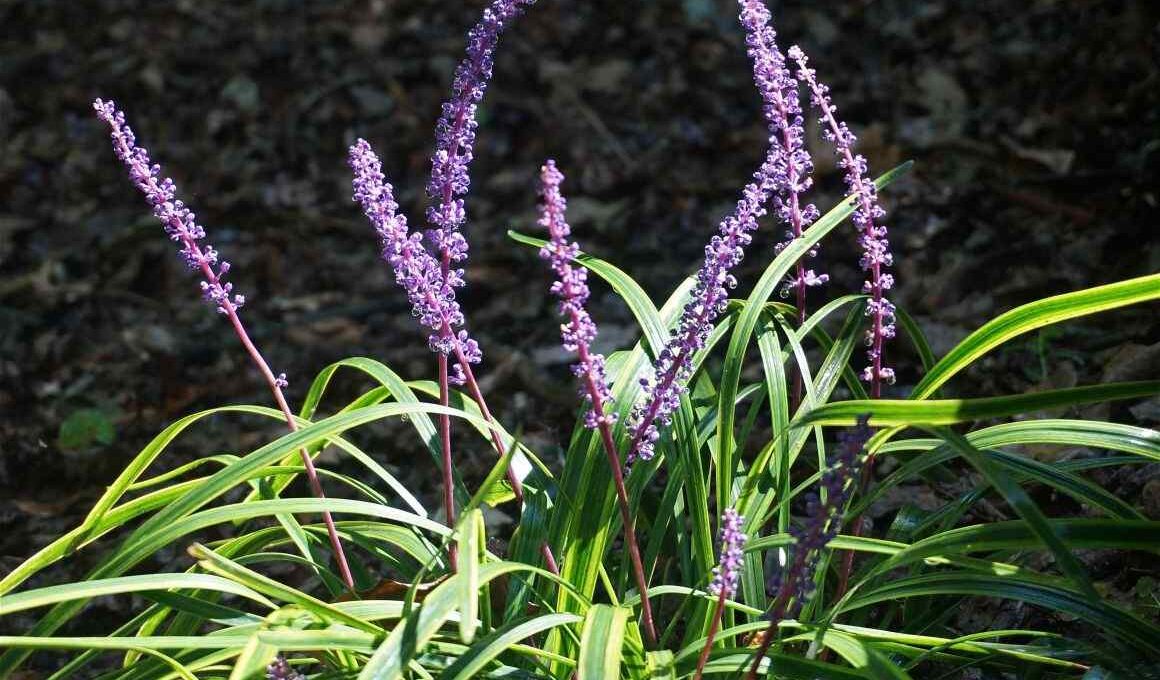Liriope Grass: Basic Information
Liriope plant genus is a member of the Asparagaceae family, which also includes garden asparagus. The Liriope genus consists of about 7 species of evergreen, grass-like plants that are native to temperate regions of Asia. Many liriope species are commonly used as ornamental plants in gardens and landscapes due to their attractive flowers and foliage. Liriope plant genus is also known by the common name monkey grass. The most common species in cultivation is Liriope muscari, which is commonly known as border grass or simply monkey grass as well.
Liriope Grass: Appearance
Liriope muscari is a clump-forming, evergreen perennial that produces small, purple flowers in summer. While it is often mistaken for a grass or lily, the Liriope genus is actually neither of them. Instead, it belongs to the Asparagus family, which also includes such diverse plants as agave or Joshua tree.
Liriope Grass: Habitat and Distribution
The Liriope genus is a group of flowering plants that are native to Asia. They can be found in a wide variety of habitats, from woodlands to gardens. The plants are typically evergreen, and they have long, strap-like leaves. The flowers grow in clusters, and they can be white, purple, or blue. Most species of liriope grass prefer shady areas, but some will tolerate full sun. In general, the plants are relatively easy to care for, and they are often used as ornamental plants in landscaping.
Liriope Vs. Ophipogon
Liriope may also be called lilyturf in North America, which is a closely related plant to Ophiopogon genus. Liriope and ophipogon are two different genera of plants that are actually quite similar in a number of ways and belong to the same family (Asparagaceae). Common species of Ophipogon include: Ophipogon japonicus (known as mondo grass or dwarf lily turf) and Ophiopogon planiscapus. Both genera grow in clumps and are relatively drought tolerant. They can be recognized by different flower spikes.
Ophipogon Genus
The Ophipogon genus is a diverse group of plants that are found all over the world, mostly in temperate grassland ecosystems. Botanists have identified several distinct subgroups within this genus, including sections and species. Common characteristics of ophipogon plants include grass-like leaves, small berries, and underground tubers. These tubers are an important resource for many different types of wildlife, ranging from small mammals to birds and insects.
Species of Liriope Grass
The Liriope genus contains several species of grassy plants that are native to Asia. The species include:
- Liriope muscari;
- Liriope spicata;
- Liriope minor;
- Liriope graminifolia;
- Liriope kansuensis;
- Liriope longipedicelata.
Species of Liriope: Liriope Muscari, Also Called Monkey Grass
Liriope muscari, more commonly known as simply monkey grass, is a highly versatile plant that is well-suited for many growing conditions. It is a fragrant, flowering turfgrass. This unique plant requires special care in order to thrive, as it does best in full sunlight and well-drained soil. Other names include: big blue lilyturf and border grass (not to be confused with species of Ophipogon).
Liriope Spicata (Lilyturf)
Liriope spicata is a perennial herb that is commonly known as creeping lilyturf or border grass. Lily turf is often used as an ornamental plant. However, it can become invasive if it is not properly controlled. The plant spreads rapidly by underground rhizomes, and it can quickly crowd out native vegetation. What’s more, the dense foliage of Liriope spicata can impede the growth of other plants by blocking out sunlight.
In some cases, the plant can also alter soil chemistry, making it inhospitable for other species. For these reasons, it is important to exercise caution when planting Liriope spicata in gardens or other areas where it might come into contact with native vegetation.
Is Liriope Genus a Low-Maintenance Plant to Grow?
The Liriope genus is an extremely hardy group of plants that has evolved to tolerate a wide range of environmental conditions and soil types. However, the best soil conditions should vary from 6.0 to 7.0 pH (slightly acidic or neutral), which is right for most garden plants. Generally speaking, Liriope is a tough and easy to plant genus that grow well even in part shade and does not require a lot of attention.
Benefits of Liriope
Liriope is a genus of flowering plants that is often used as groundcover in gardens and yards. These low-growing plants have broad, grass-like leaves, and their inconspicuous flowers give way to clusters of small, blue-black berries. One of the great advantages of using liriope grass as ground cover is that they are extremely drought-tolerant and require very little maintenance. Moreover, their spreading growth pattern helps to crowd out weeds, thereby reducing the need for regular weeding and herbicide applications.
Propagation of Liriope
There are a number of different ways to propagate the Liriope genus, including by seeds or by division. Seeds are usually sown directly into the soil in spring or early summer. Once germinated, seedlings require careful and consistent care over the following few months in order to become well established.
Alternatively, if you prefer to propagate your liriope by division, this can be done before growing season, usually in spring. To divide your liriope grass successfully, cut at least one section of rhizome with at least one growth fan attached and one flower bud. Replant this piece immediately and water thoroughly until it becomes established.
Common Problems
Liriope grass is known for its attractive foliage and distinctive flowers, but it can also be susceptible to a range of common insect pests, such as mealybugs and aphids. These small insects feed on plant sap, causing physical injury to the plant as well as weakening it and making it more vulnerable to disease. If these insects are detected early, they can be easily controlled with simple methods like hosing off foliage with water or applying an insecticidal spray.



















